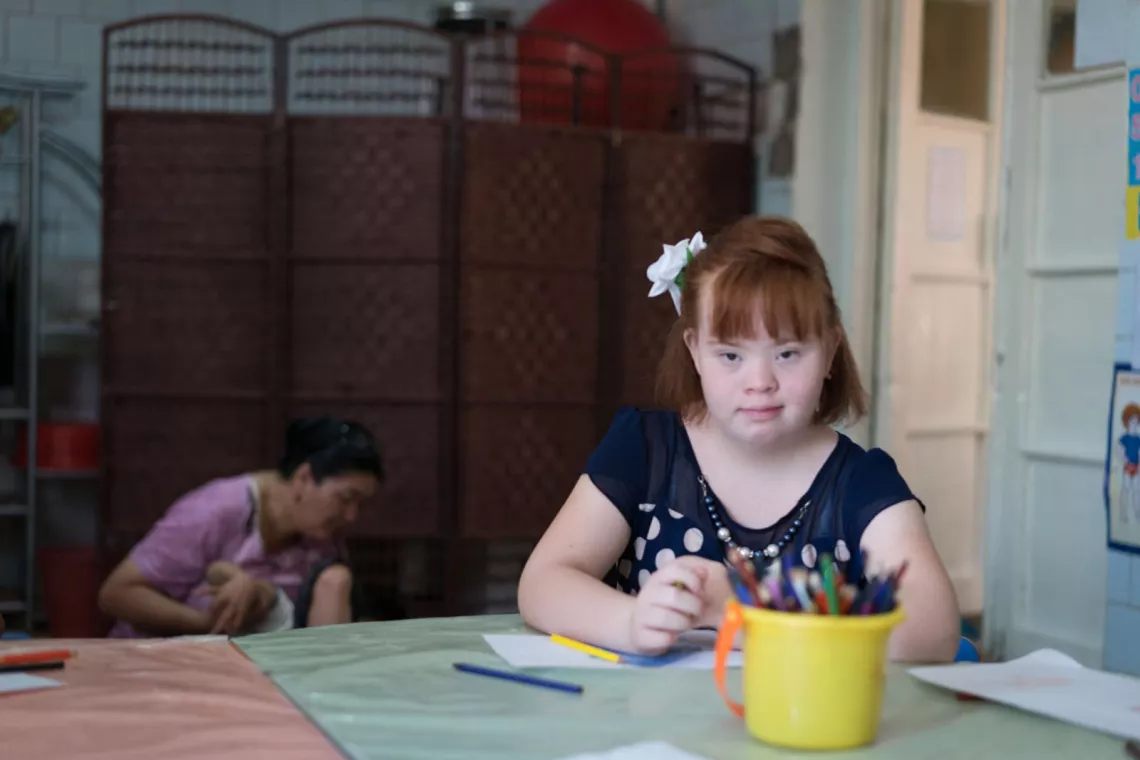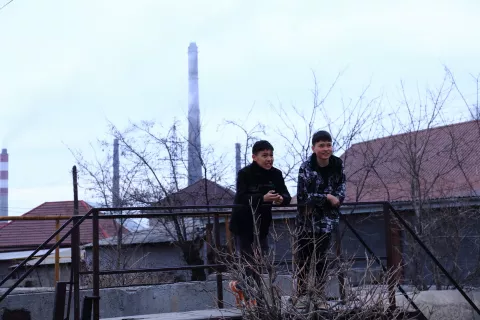Children with disabilities: Home sweet home
On the outskirts of Osh, Kyrgyzstan’s second city, a cheerful sign greets visitors at Buchur Day-care Centre for Children with Disabilities

Her smile of welcome floods the room like the sun piercing through a long night. She hugs us, snaps a selfie, and breaks into a brash but pitch-perfect rendition of a hit by the popular American singer, Ariana Grande.
She grabs her smartphone, and her fingers fly as she edits a video. It’s a skill she learned at a UNICEF workshop that teaches young people technical skills to give them a voice in issues that affect them.
She posts her video on social media – her friends rush to ‘like’ it.
“My daughter is so talented,” her father says, smiling. “I’m so proud of her.”
Children [with disabilities] need care, love, attention, and then education … That makes all the difference.

Guliza Muzafar Kyzy is your everyday 17-year-old, except for one thing: she has had cerebral palsy since birth. Munching cookies around her dining room table, it’s hard to imagine – even for a moment – what growing up might have been like for this bright teenager in her ponytail.
“When I see other children dance and play, I can’t,” Guliza says matter-of-factly.
Guliza lives her life to the fullest. She graduated with honours from a US-funded English-language programme. Her schoolteachers visit often and friends stop by. Her parents have made sure she is autonomous, at least indoors: they have positioned metal bars along their apartment walls so she can move around. To go out, her father carries her down four flights of stairs and back with enthusiasm, even though his daughter weighs more each year.
Institutionalization: all too common
Guliza is fortunate. She lives at home, but about a third of children with disabilities in Kyrgyzstan end up in institutions. Some of these children are orphans: if they have families, they may be too poor to care for them, especially if there is no community care available, or they may refuse due to social stigma shown toward disability. Even some hospitals and kindergartens have encouraged parents to abandon children with disabilities and place them in institutions.
In many cases, parents believe their children will be better off with specialized care that deals with disabilities and helps integrate their children into society.
“We visited a boarding school in Bishkek because we thought it would be good for Guliza to be with other children more like her,” explains Guliza’s mother, Jyparjul Samieva. “But when we saw the conditions in which the children were kept, with most of them abandoned by their parents, we couldn’t leave our daughter there.”
Changing hearts and minds
While placing children in institutions has been the norm since Soviet times, authorities are questioning the approach and seeking alternatives.
“Rather than make residential care the rule, UNICEF would like it to be the exception, with family care at the top of the list, followed by fostering in alternative care,” said Munir Mammadzade, UNICEF Chief of Child Protection in Kyrgyzstan. “By developing a model of integrated community services for children with disabilities, everyone would work together to identify disability early in life and remove the barriers they face when trying to access services.”
To ensure children with disabilities are diagnosed early and receive the care and services to which they are entitled, UNICEF is introducing early identification for children eight and under. The health service will help detect disability or difficulties in a child’s development and support families in working with a child’s condition and environment.
The best scenario, says Mammadzade, is one in which social services treat children with disabilities – with the exception of particularly complicated situations – like all other children instead of keeping them apart.
Sadly, though, social workers and facilities that focus on integration are scarce. Where they do exist, they fill up rapidly, a testament to their success, and the need for more.
When the community cares
On the outskirts of Osh, Kyrgyzstan’s second city, a cheerful sign greets visitors at Buchur Day-care Centre for Children with Disabilities. Each week, some 20 children aged 2-16 spend a few hours learning skills ranging from attentive listening to maths, and how to play together. The rest of the time they are either at home, or in school.
For parents, Buchur is a blessing. “Both my children have Downs’ syndrome,” one mother shares in a quiet voice, hugging each in turn. “My boy, who is 8, goes to a special school and can read four-letter words. My daughter is only four-and-a-half but she can read letters and numbers.”
Her eyes sparkling with love, Galina – not her real name – expresses her good fortune. “We have some support, my husband is in the military,” she says. “He adores his children. I know that in some families it might not be the same.”
The mothers are excited about bringing their children to the day-care centre and watching them improve: an autistic boy who once sat at home rubbing a bottle all day now counts, reads letters and plays with other children. A five-year-old girl with severe learning disabilities attends regular classes, and another child who couldn’t walk is not only walking but playing and communicating with other children.
“Of 21 children who come here weekly, eight go to regular school,” says the centre’s director, Elvira Makeeva. “What we do here is help them sustain and improve their skills.”
Established by UNICEF, the day-care centre is now administered by the city authorities and funded by the local budget, ensuring its survival.
“Children need care, love, attention, and then education,” Makeeva says. “That makes all the difference.” Yet too many children with disabilities are still being left out of society’s mainstream.
“Much more can be done,” said Mammadzade, “but there is no comprehensive programme in the country, only scattered pieces.”
UNICEF is working to improve the availability of essential services for children with disabilities, building the skills of those who work with these children and their parents, and preventing the stigma that encourages placing these children in institutions. UNICEF also works with governments to develop better parenting, and to develop community-based services that emphasize children with disabilities. It helps streamline work across ministries and reduce administrative complications for families.
Centres like Buchur may not be plentiful, but they are successful in helping children with disabilities attend regular schools and integrate more easily into society. Buchur and similar establishments prepare children for kindergartens, which do not normally accept children with any disabilities. Those children already in regular schools go to Buchur for extra help with homework and access to rehabilitation services.
Had Guliza’s parents known about Buchur or centres like it, she probably would have been enrolled, learning to develop her unique talents and skills in a nurturing social environment.
As we say goodbye to Guliza, a gleeful sound follows us down the stairs of her Soviet-era brick building and into the bright midday sunlight.
“Please go shoot some footage for me,” we hear her tell her mother. “Then I can edit it and we can earn some money.” She bursts out laughing.
She is, after all, the ‘techie’ of the family, helping relatives find their way around their new smartphones.
Indeed, every inch a teenager.





